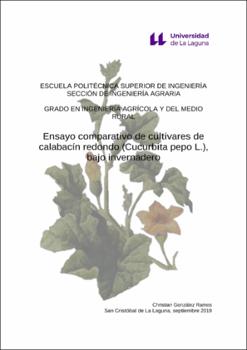Ensayo comparativo de cultivares de calabacín redondo (Cucurbita pepo L.), bajo invernadero
Fecha
2019Resumen
Zucchini (Cucurbita pepo L.) has experienced an important growth in the
last years. As a consequence of this, a crop has been established that
agronomically compares „Geode‟, „Satélite‟ and „Redondo de Niza‟ cultivars
under greenhouse conditions. The test was realized in the EPSI department of
the University of La Laguna, Tenerife, under a flexible thermal polyethylene
greenhouse, with an area of 59.5 m2
. Following a randomized statistical design
of blocks with three cultivars („Geode‟, „Satélite‟ and „Redondo de Niza‟), and
three repetitions, with border plants. Previously, a seedbed was made in
expanded polystyrene and with a substrate of peat moss. Once the plants were
germinated and when the seedlings had an adequate development, they were
moved to the final seating area, with a 1.5 x 0.5 m plantation frame. The crop
took place without major incidents and the appropriate maintenance work such
as irrigation, fertilization, etc., were carried out until the time of collecting. At this
point, we proceeded taking the collecting data that were necessary for the
subsequent study of the agronomic parameters: Weight, length, diameter and
yield of the cultivars. These were analyzed using statistical methods of analysis
of variance, after checking the hypothesis of Homocedasticity and Normality. It
was concluded that „Geode‟, „Satélite‟ and „Redondo de Niza‟, have not had an
optimum performance at productive levels as a result of the low temperatures
registered during the fruit development period. However, there is a notable
difference between „Satélite‟ and „Geode‟ with „Redondo de Niza‟ in favor of the
first two. El calabacín (Cucurbita pepo L.) ha adquirido una notable importancia en
estos últimos años. Como consecuencia de esto, se ha establecido un cultivo
que compara agronómicamente los cultivares Geode, Satélite y Redondo de
Niza en condiciones de invernadero. El ensayo fue llevado a cabo en las
instalaciones de la EPSI de la Universidad de La Laguna, Tenerife, bajo
invernadero de polietileno térmico flexible, con una superficie de 59,5 m2
.
Siguiendo un diseño estadístico de bloques al azar con tres cultivares („Geode‟,
„Satélite‟ y „Redondo de Niza‟), y tres repeticiones, con plantas borde.
Previamente se realizó un semillero en bandejas de poliestireno expandido y
con un sustrato a base de turba. Una vez germinadas las plantas y cuando las
plántulas tenían un desarrollo adecuado, se pasaron al terreno de asiento
definitivo, con un marco de plantación de 1,5 x 0,5 m. El cultivo transcurrió sin
grandes incidencias y se realizaron las labores oportunas de mantenimiento
como riego, fertilización, etc., hasta el momento de la recolección. Llegado este
punto, se pasó a la toma de datos que eran necesarios para el estudio posterior
de los parámetros agronómicos: Peso, longitud, diámetro y rendimiento de los
cultivares. Éstos fueron analizados mediante los métodos estadísticos de
análisis de la varianza, previa comprobación de las hipótesis de
Homocedasticidad y Normalidad. Se concluyó que „Geode‟, „Satélite‟ y
„Redondo de Niza‟, no han tenido un comportamiento óptimo a niveles
productivos como consecuencia de las bajas temperaturas registradas durante
el periodo de desarrollo de los frutos. Sin embargo, hay una diferencia notable
entre „Satélite‟ y „Geode‟ con respecto al „Redondo de Niza‟ a favor de las dos
primeras.





